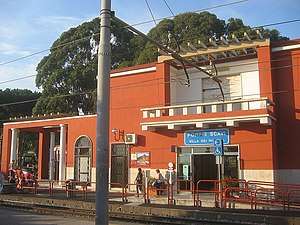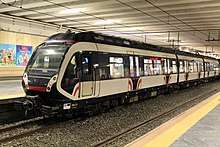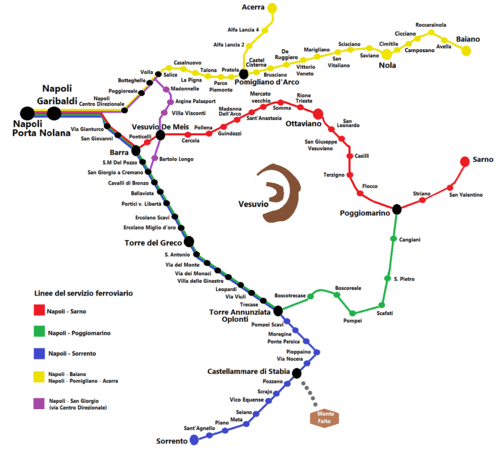Circumvesuviana
Circumvesuviana (Italian pronunciation: [ˌtʃirkuɱvezuˈvjaːna]) is a railway network in the east of the Naples metropolitan area, previously run by a company of the same name, now operated by it:Ente Autonomo Volturno. Electrically powered throughout, the system uses the narrow gauge of 950 mm (3 ft 1 3⁄8 in) and operates 142 km (88 mi) of route on six lines. It is entirely separate from other national and regional railway lines. It has 96 stations with an average interstation distance of 1.5 km (0.9 mi).
 | |
| Industry | Transport |
|---|---|
| Fate | merged into Ente Autonomo Volturno, 2012 |
| Founded | Naples, Italy (1890) |
| Headquarters | Naples , Italy |
Area served | Bay of Naples |
| Services | Local Public Transport Railway |
Number of employees | 1590 |
| Website | eavsrl |


The Circumvesuviana railway covers a wide catchment area of over 2 million people, distributed in 47 municipalities, including Scafati, San Valentino Torio and Sarno in the province of Salerno and Avella and Baiano in the province of Avellino. The network forms an important commercial artery, and provides services to the tourist destinations of Pompeii and Herculaneum.
All routes start from the Napoli Porta Nolana terminus near the Porta Nolana, and pass through Napoli Garibaldi station before splitting into several branches to towns in the province. A journey along the entirety of the longest route, the 47 km (29 mi) from Naples to Sorrento, takes about one hour.
On 27 December 2012 the original company was absorbed by the it:Ente Autonomo Volturno.
Lines
All lines are powered by electric overhead lines.
| Lines | Opening | Length | Stations | Route | Stops | Travel time |
|---|---|---|---|---|---|---|
| Naples – Baiano | 1885 | 38 km (24 mi) | 28 | Porta Nolana - Nola - Baiano | 28 | 59 minutes |
| Naples – Sarno | 1891 | 38 km (24 mi) | 28 | Porta Nolana - Ottaviano- Sarno | 28 | 65 minutes |
| Naples – Poggiomarino | 1904 | 35 km (22 mi) | 25 | Porta Nolana -Scafati - Poggiomarino | 25 | 57 minutes |
| Naples – Sorrento | 1932 | 47 km (29 mi) | 36 | Porta Nolana - Torre Annunziata - Sorrento | 36 | 68 minutes |
| Branch Botteghelle – San Giorgio |
2001 | 8 km (5 mi) | 7 | Porta Nolana - Centro Direzionale - San Giorgio[1] | 11 | 15 minutes |
| Branch Pomigliano d'Arco – Acerra |
2005 | 3 km (1.9 mi) | 4 | Porta Nolana - Pomigliano - Acerra[2] | 16 | 28 minutes |

Rolling stock
The network uses two types of rolling stock, both electrically powered: FE220 units, and ETR211 "Metrostar" articulated trains. Power is supplied by overhead catenary and the train motors can generate up to 500 kW (670 hp) of power.
The FE220 cars are usually coupled together to form a two- or three-car multiple units, painted white with red doors and ends. There FE220 trains come in two different variations.
Twenty-six ETR211 "Metrocar" three-car articulated units were introduced[3] between November 2008 and September 2009. Manufactured by a consortium of Firema and AnsaldoBreda, these trains are capable of carrying 450 passengers and are styled by Pininfarina. As well as being more powerful than the FE220 units, they have computer driving aids, self-levelling suspension. These units are mostly used to provide the express service whilst the FE220 provide cheaper, stopping services which tend to be far more crowded.
Notes
- path in common with the Napoli - Baiano to the station Botteghelle.
- path in common with the Napoli - Baiano to the station Pomigliano d'Arco.
- Ecco "Metrostar", il nuovo treno della Circumvesuviana
See also
- Metropolitana di Napoli
- List of suburban and commuter rail systems
External links
- Official Circumvesuviana site (In Italian, last updated 2002)
- Unofficial site (mostly in Italian with a summary in English)
- Current schedules on the EAV site (In Italian, but schedules are numeric once you select a line)
